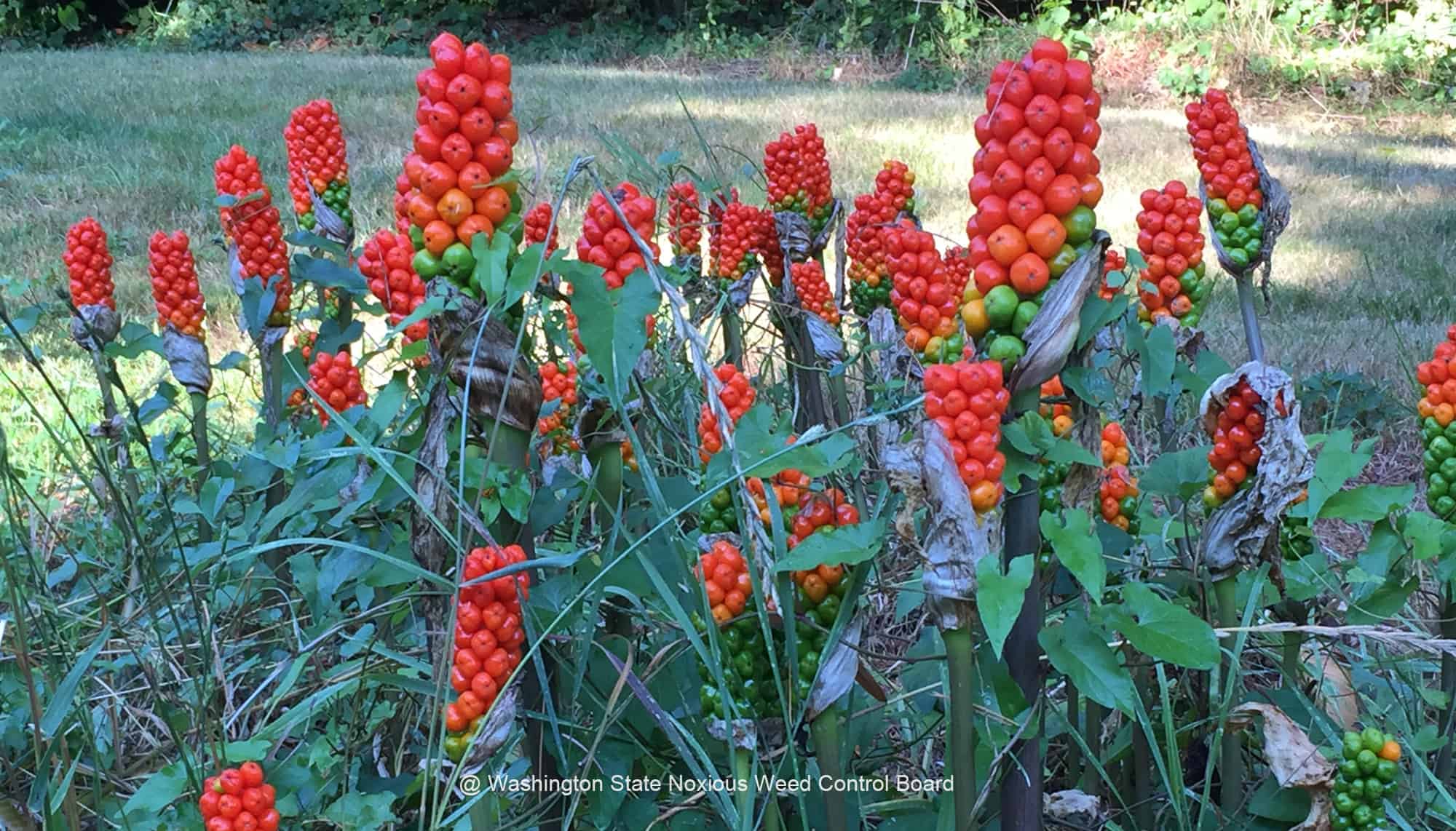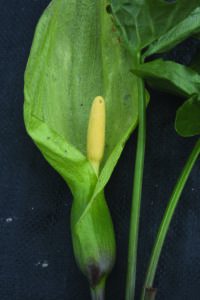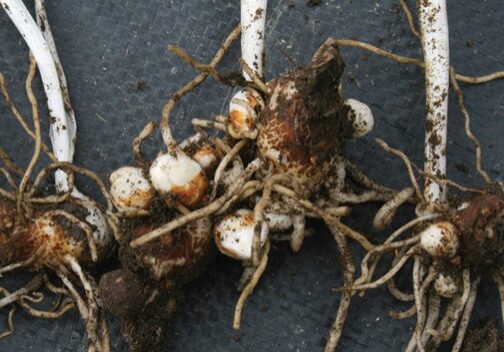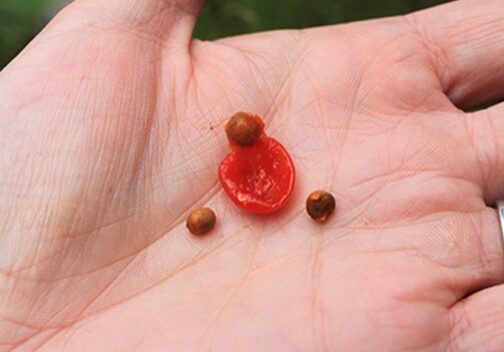Italian Arum


Italian Arum: Beautiful, Poisonous and Invasive
Don't Be Deceived by This Beautiful Ground Cover
By Valerie Rose, Skagit County WSU Extension Master Gardener
What a deceptive plant! First of all, Italian Arum (Arum italicum) is not strictly Italian. Native to Asia, Europe, and North Africa, some botanical resources say it’s also found in southern Europe. Other common names include Cuckoo’s Pint, Italian Lily, and Orange Candle Flower. While many of these names point to Italy as the source of this problematic plant, its roots appear much more widespread.

Italian Arum is also deceptively attractive. The bright orange berries brought color to an otherwise nondescript area of the yard, so I let it grow. Now I wish it had never found my address. It now appears in most of my garden beds, even in the lawn, where it has made friends with the equally intrusive buttercups. They’re conspiring to take over the whole yard, and I struggle to keep them at bay. We gardeners are seriously outnumbered.
My yard is not alone. In addition to being a pest in Skagit County, the plants are found between 10 and 100 acres in Whatcom, King, Skamania, and Clark Counties. More acres have been infested since that figure was published in 2018 by the Washington State Department of Agriculture (WSDA.) Italian Arum is also invading forest understories and wetlands, forming dense infestations, and crowding out native plants.
Because it is so invasive and poisonous to humans and animals, the WSDA classifies it as a Class C Noxious Weed. The WSDA describes Class C Noxious weeds as those “… already widespread in Washington. In some cases, counties may require property owners to control Class C weeds, but more often counties simply try to educate residents about why controlling them is a good idea.”
What about Class A and B weeds? The WSDA describes these categories:
“Class A Noxious Weeds are non-native species whose distribution in Washington state is still limited. Eradicating existing infestations and preventing new infestations are the highest priority. Eradication of all Class A plants is required by law.”


Class B noxious weeds are nonnative species whose distribution is limited to portions of Washington state but may be widespread in other parts. Class B noxious weeds are designated for mandatory control in regions where they are not yet widespread.”
Like many invasive plants, Italian Arum likely escaped from someone’s garden. Originally planted as an ornamental ground cover, it certainly does cover ground. The first documented site in Washington state was on San Juan Island in 2002. This (ob)noxious weed is currently invading the west coast of the US and lower mainland British Columbia and across the mid-Atlantic states.
Not only is this plant invasive, but it also contains calcium oxalates, poisonous to humans and animals. According to the North Carolina Extension Gardener Toolbox, the calcium oxalates, if ingested “…will cause throat and tongue swelling that will result in difficulty breathing or possible death.” Simple skin contact can cause mild to severe irritation. Always protect your skin when attempting to remove Italian Arum.
Unfortunately, the plant tolerates most soil types, is drought tolerant once established, and thrives in partial shade to full sun. Like many undesired plants, it has more than one reproductive strategy. It grows from both tubers and berries, reaching 12 – 18 inches tall. The arrow-shaped leaves appear in early autumn, with hood-like flowers blooming in April and May: their acrid odor attracts flies as pollinators. When the foliage withers, stalks emerge, eventually covered in clusters of berries. The plump berries are initially green, changing to a vivid orange-red. This dramatic show continues through August, giving birds plenty of time to snack on the berries, and then deposit the seeds around your yard and beyond - conveniently coated with fertilizer.
Once established, Italian Arum is maddeningly difficult to get rid of. According to the North Carolina Extension Gardener Plant Toolbox, “There are no effective ways to control the plant, and it is unresponsive to herbicides. Manual removal is difficult. If removed, all parts of the plant should be placed in the trash and not your compost bin.”



An Oregon State University Extension’s Ask An Expert webpage offers this: “Some suggest success by pouring boiling water on the plant’s roots. If using vinegar, a 20% vinegar solution is best. This type of vinegar, sometimes called horticultural vinegar, can be found at garden centers, farm stores, or online. Wear gloves and protective clothing to protect your skin from possible irritation. Follow–up work will be required to control any plants that develop from missed plant parts.” I will explore this strategy, as my annual ritual of carefully digging the roots and bulbs has not eliminated this invasion.
Don’t let the pretty leaves or colorful berries fool you into letting Italian Arum take root in your yard. And tell your friends and neighbors not to allow Italian Arum to charm its way into their gardens.
RESOURCES:
- Washington State Noxious Weed Control Board
https://www.nwcb.wa.gov/weeds/italian-arum - https://www.skagitcounty.net/Departments/NoxiousWeeds/weedlist.htm
- North Carolina Extension Gardener/Plant Toolbox
https://plants.ces.ncsu.edu/plants/arum-italicum/ - https://cms.agr.wa.gov/getmedia/8e970f5e-72b0-4dcc-99d5-a1c9aad48ef7/ItalianArum.pdf
Italian Arum Distribution, 2018, Washington State Department of Agriculture - Clackamas County Weed Wise
https://weedwise.conservationdistrict.org/arit-2 - Oregon State University Extension, Ask An Expert
https://extension.oregonstate.edu/ask-expert/featured/how-can-i-organically-get-rid-italian-arum - https://www.co.cowlitz.wa.us/DocumentCenter/View/13974/Italian-Arum

ABOUT THE AUTHOR:
Valerie Rose became a Master Gardener in 2009. A former journalist, she enjoys playing with words, and plants other than Italian Arum.
Questions about home gardening or becoming a Master Gardener may be directed to: Skagit County WSU Extension Office, 11768 Westar Lane, Suite A, Burlington, WA 98233; by phone: 360-428-4270; or via the website: www.skagit.wsu.edu/mg